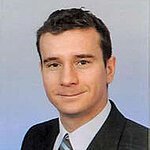Virtual sensors provide early warning against potential breakdowns
Digital twin looks ahead
The hydropower plant of the future will be a “transparent power plant.” What that means is that comprehensive, detailed information about the current and expected state of the plant will be available on a continuous basis, ideally precise to the second. VERBUND Hydro Power GmbH (VHP) – one of the major European hydropower companies – aims to achieve this goal using digital twins and virtual sensors.
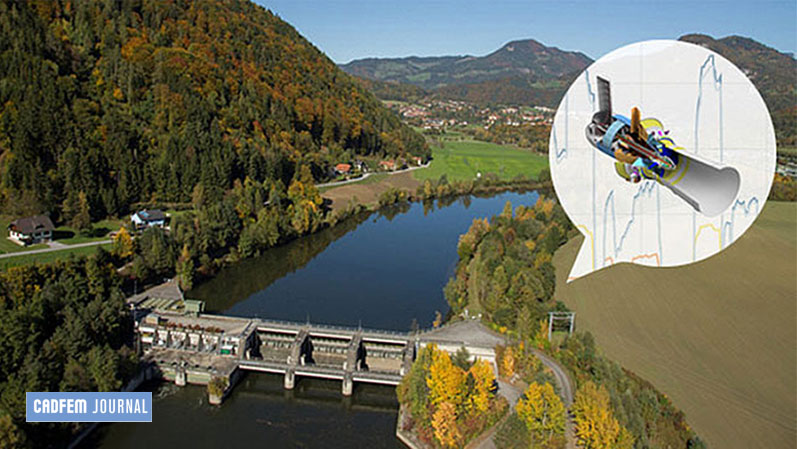
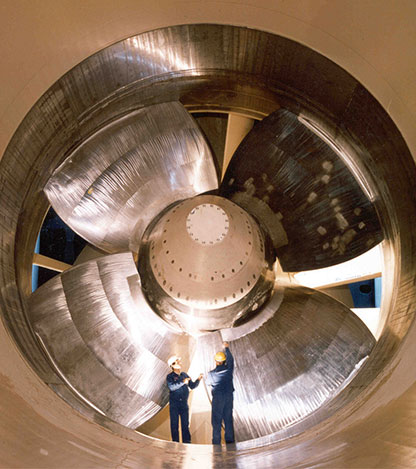
"With our innovation program ‘Hydropower 4.0 – Digital Hydropower Plant,’ we are staking out ambitious new goals. We are examining every conceivable possibility to make use of existing and future digital assistance methods in hydropower applications. In the process, we are breaking new ground in order to tap additional significant reserves in terms of efficiency and safety,” says Managing Director Karl Heinz Gruber, describing the strategic objectives of VHP. This includes interactive troubleshooting and digitalized predictive diagnosis functions for systems and components.
Greater transparency in the “digital hydropower plant”
Thanks to new analytical methods and the use of self-learning computer systems, the resulting deluge of data can then be used to generate new insights into the current state of the system. With computer simulations drawing on the status updates and forecasts, coupled with the system’s “history,” downtimes and repair times can be reduced by enabling the operator to identify potential breakdowns due to unplanned incidents in good time.
Either alone or with partners, VHP operates over 120 hydropower plants in Austria and Germany. Together with internal and external experts, the research community, consultants and equipment manufacturers, VHP focused on two main issues with the new initiative: “digital workflow management” – i.e. mobile solutions for digital planning and processing of work processes by colleagues onsite – and the “digital hydropower plant,” with a very broadly conceived project description and an extremely innovative character.
Engineer Dr. Bernd Hollauf, project director for the digital hydropower plant, explains: “Our hydropower plants were already 100% automated and are controlled through centralized bases. As a rule, the power plants are therefore unmanned and people are only on location for checks, when errors occur or inspections are carried out. There is sensor technology in place for machinery, buildings and the environment, including central process data archiving.”
However, the systems are generally still stand-alone solutions, and the aim now is to connect them as far as possible. To achieve this, Dr. Hollauf and his colleagues are taking a look at many different industries to identify solutions that can be used to connect a wide range of different digitalization technologies. “Our objective is to provide the most comprehensive support possible for staff on location using digital aids,” emphasizes Dr. Hollauf. One part of that is examining what added value we can generate out of the existing data. At the same time, in addition to the digital twin, we are also deploying new tools for measurement and inspection of the riverbeds, for instance with autonomous vehicles from the surface of the water or with remotely controlled underwater vehicles such as diving robots."
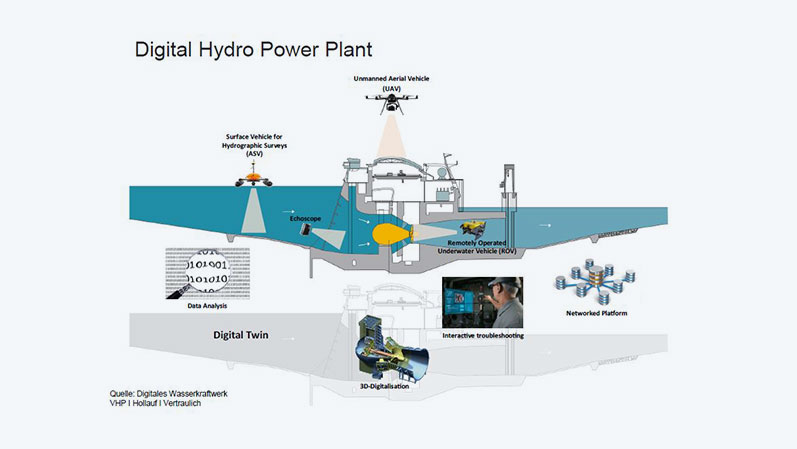
Pilot application at the Rabenstein power plant
The representative Rabenstein power plant in Styria, a medium-sized run-of-river plant on the Mur river, was selected for the pilot application. The plans for the roughly 30-year-old power plant are still in paper form, which means it will be possible to apply the experience gained here to other power plants, which are usually older
“Our conception of a digital twin includes the use of simulations. That is why we selected the CADFEM Group, which has worked with us as a simulation partner in product development for many years, and supported us with advice and assistance as our ANSYS provider, as our partner,” says engineer Michael Artmann, Project Manager for the “Digital Twin” subproject at Hydro Power GmbH. The project is being headed up by the Swiss company ITfi cient AG, a start-up that is a part of the CADFEM Group and which specializes in big data analysis and the preparation and integration of sensor data and other data sources.
Simulation-based digital twins are most useful where components are subjected to varying stresses that cannot be predicted in advance. This makes it possible, for example, to predict wear or degradation such as crack formation due to excessive stresses, which in turn enables timely replacement of the component before damage occurs. To conduct a pilot project, a component was selected that is located in the adjustment mechanism of the turbine runner.
Simulation models for strength calculations
As the basis for the simulation, the fi rst step was to create a 3D CAD model of this adjustment lever using the existing design drawings. The subsequent strength calculations showed the critical points with the maximum stresses on the component. In order to carry out a rapid yet precise calculation, a simplifi ed behavioral model was generated based on that information. With that in place, physical sensor data makes it possible to determine the current stresses at the hot spots with a high degree of certainty at any time, enabling a robust service life calculation on that basis.
calculations under the FKM guideline (analytical strength assessment of mechanical components), Michael Altmann explains: “The respective movements on the real system then supply the corresponding stresses for the digital twin operating in parallel. The service life assessment, which we had previously conducted with an Excel spreadsheet based on the load spectra derived from the manner of operation, can now be further developed, thanks to the introduction of the digital twin, into an evaluation based on the actually occurring load spectra.” This pilot project served as a proof of concept for the digital twin concept proposed by ITfi cient and CADFEM and was successfully completed.
Dashboard provides complete overview in real time
The digital twin and the accompanying data analysis were designed as a platform- neutral solution that could be easily integrated into the existing VHP infrastructure. In the solution, all data required for the calculation – and much more – is managed, analyzed and visualized by ITfi cient. A dashboard provides a complete overview of Rabenstein turbine 1 in real time, including the data from sensors and virtual sensors as well as the remaining service life. This makes it possible to assess the availability of relevant system components and initiate any necessary measures in good time. For the analysis, individually defined time periods and metrics can be examined and the selected data displayed in graphic or tablular form. This makes it possible to select specific correlations between different data points independently.
The next step is to include further components as digital twins, with aspects such as flow analysis and electromagnetic simulations being possible candidates in addition to structural calculations. Insights that lead to a change in the operating conditions are invaluable information. Simulations make it possible to investigate any number of different use scenarios, which in turn make it possible to select the ideal operating mode (optimized operation) based on the actual system status. In the subsequent prototype phase, the respective pilot projects are then prepared and implemented by ITficient and CADFEM.
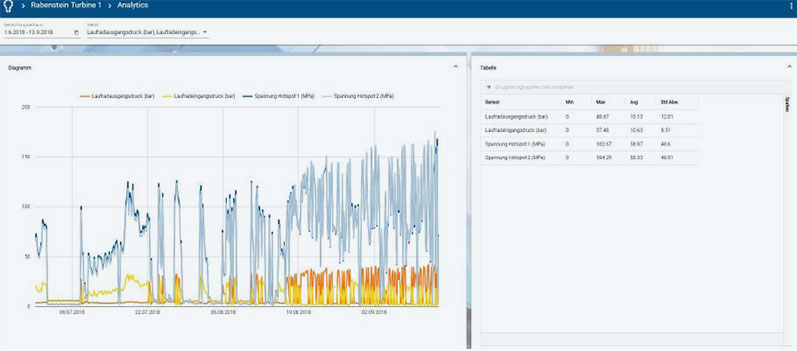
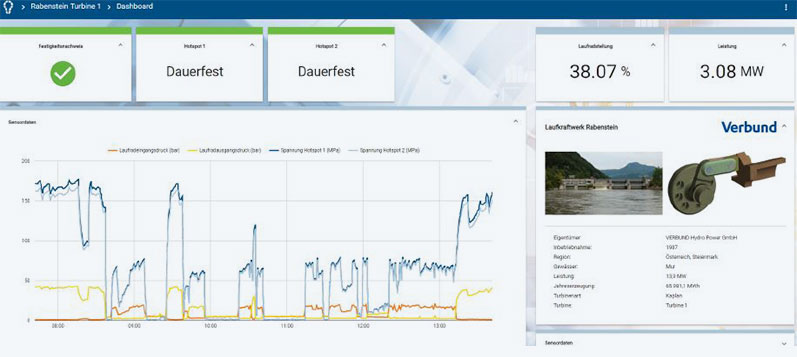
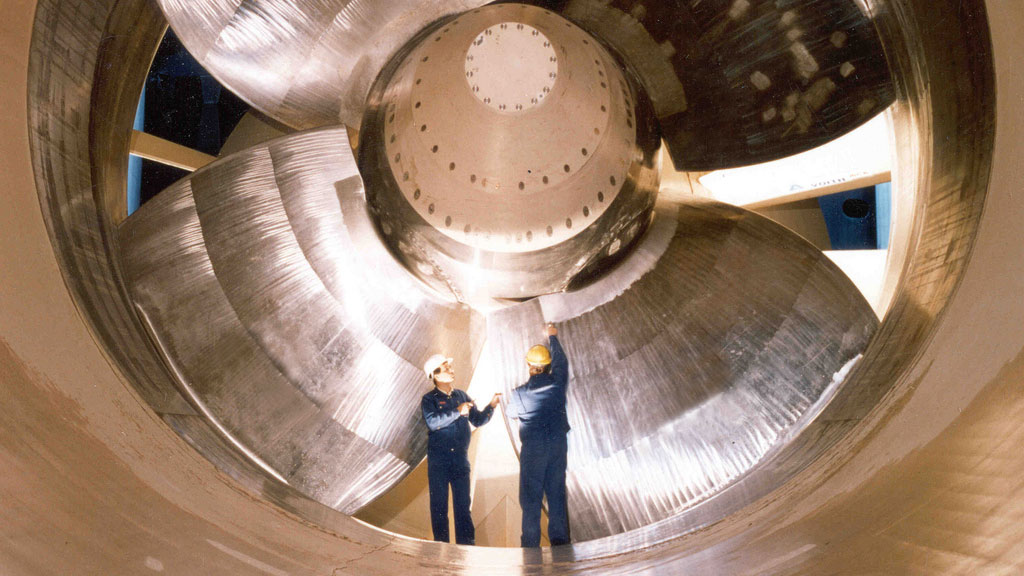
Assessing different scenarios
“While we were looking at the potential benefits of the digital twin, it became clear to us that we should start by focusing on just a few components and study a wide variety of different scenarios for them,” says Michael Artmann. “This process of asking ‘what if X happens’ can provide us with greater insight into how to operate the system in a system-friendly way or what it means for the service life if the system is operated under very high loads.”
The strategic objectives are the provision of the requisite amount of energy at the right time and the possibility of combining volatile photovoltaic and wind power generation with network-controlled hydropower in an economical manner. In addition to the evaluation of system operating modes from an economic standpoint, another significant motivation behind the digital twin is the information gained about the state of the system and the implementation of predictive maintenance so as to avoid unplanned downtimes and maximize availability.
One interesting sub-aspect is the question of how much the empirically determined length of inspection cycles can be extended. Dr. Hollauf was particularly pleased that in commissioning ITficient and CADFEM, they were able to tap an existing partnership. Moreover, he appreciates the agile development process, with short development steps and direct implementation of feedback from Verbund: “With the milestones in place, we’re able to assess very quickly whether we’re on the right track together or whether we need to make adjustments or perhaps change course. That was particularly useful at the beginning, when we first had to develop a common perspective and objective, which we then set about doing step by step.”
Individual recommendations for power plants
Overall, everyone involved in the VHP project is very pleased with what has been accomplished to date. Within a space of ten weeks, the proof of concept was developed and implemented from the 2D drawing to the operable digital twin. “Based on what we’ve achieved here, we are very optimistic that we will be able to expand the pilot phase, or perhaps even bring the evaluation to a close, in 2019 in order to roll it out more fully following a positive assessment,” reports Dr. Hollauf.
“In addition to achieving the highest possible availability of the hydropower plants, we also aim to get a more well-founded forecast of their remaining service lives. We also expect benefits in terms of condition- based servicing and the avoidance of expensive repairs. Furthermore, we intend to create recommendations for the individual power plants in order to make the plants more economical through network- controlled operation. Based on damage analyses and pattern recognition using artificial intelligence, we aim to enhance the individual power plants on a system-specific basis.”

VERBUND Hydro Power GmbH
https://www.verbund.com/
Author: Gerhard Friederici
(CADFEM Germany GmbH)
Cover Images:
Right:© VERBUND Hydro Power GmbH
Left: © VERBUND Hydro Power GmbH
Published: April 2019
Contact CADFEM




